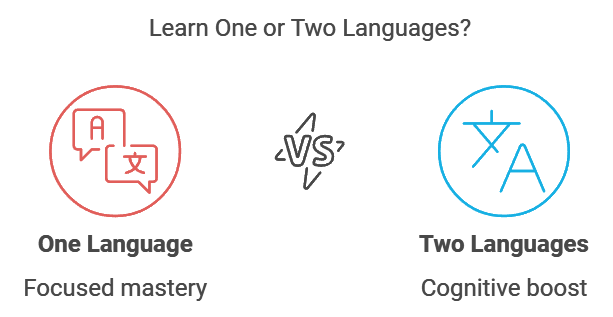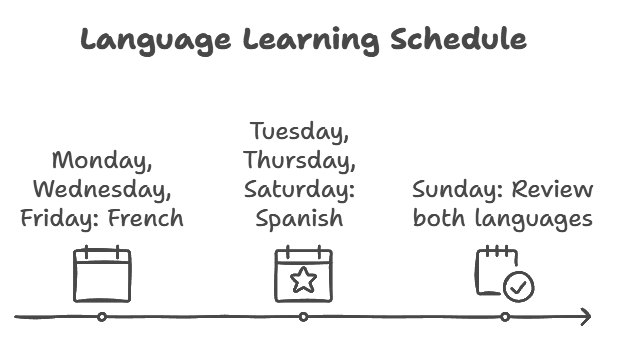Can you learn French and Spanish at the same time?
Yes, you can learn French and Spanish at the same time! While it may seem daunting, many people successfully tackle these two beautiful languages together. With the right approach and mindset, you can embark on this exciting journey of dual language learning.
Key Takeaways
• Learning French and Spanish simultaneously is possible and can be beneficial.
• The brain’s neuroplasticity allows for learning multiple languages at once.
• Leveraging similarities between the languages can speed up your learning process.
• Effective time management and study strategies are crucial for success.
• Technology and language exchange programs can greatly aid your learning journey.
• Understanding cultural aspects enhances language acquisition.
• Bilingualism in French and Spanish can open up numerous career opportunities.
The Science Behind Learning Two Languages Simultaneously
Have you ever wondered how your brain handles learning two languages at once? Let’s dive into the fascinating world of neuroscience and language learning!
Neuroplasticity and Cognitive Benefits
Our brains are incredibly adaptable. This ability, called neuroplasticity, allows us to learn new skills throughout our lives. When you learn two languages at once, you’re giving your brain a fantastic workout. This mental exercise can lead to:
• Improved memory
• Better problem-solving skills
• Enhanced creativity
• Delayed onset of age-related cognitive decline

How the Brain Processes Multiple Languages
When you learn French and Spanish together, your brain creates separate networks for each language. These networks can overlap, especially when the languages share similarities. This overlap can actually help you learn faster!
Age Factors in Simultaneous Language Acquisition
While children often pick up languages more easily, adults can absolutely learn two languages at once. Here’s a quick comparison:
| Age Group | Advantages | Challenges |
|---|---|---|
| Children | Natural acquisition, better pronunciation | May mix languages initially |
| Adults | Better study skills, life experience | May struggle with pronunciation |
Remember, it’s never too late to start your language learning journey!
Similarities and Differences Between French and Spanish
French and Spanish are like cousins in the language family. They share a lot of similarities, which can make learning them together easier.
Common Latin Roots and Cognates
Both languages come from Latin, so they share many words with similar meanings and spellings. These are called cognates. For example:
• French: “famille” / Spanish: “familia” (family)
• French: “important” / Spanish: “importante” (important)
• French: “animal” / Spanish: “animal” (animal)
Isn’t it cool how similar they are? 😊
Key Grammatical Differences
While French and Spanish share many grammar rules, they also have some key differences:
• Spanish uses two forms of “to be” (ser and estar), while French uses one (être).
• French has more silent letters and complex pronunciation rules.
• Spanish verb conjugations are generally more regular than French.
Pronunciation Challenges
Both languages have unique sounds that might be tricky for English speakers. French has nasal vowels, while Spanish has the rolled ‘r’. Practice makes perfect!
Effective Strategies for Learning French and Spanish Together
Now that we know it’s possible, how can we make it happen? Here are some tried-and-true strategies:
Leveraging Similarities: Cognates and Shared Vocabulary
Make the most of those shared words! Create a list of cognates and use them as a starting point. It’s like getting a two-for-one deal in your language learning!
Memory Techniques for Dual Language Learning
Try using the Memory Palace technique. Imagine a house where each room represents a different language. Place French words in one room and Spanish in another. This visual method can help keep the languages separate in your mind.
Time Management and Study Scheduling
Consistency is key. Try this simple schedule:
• Monday, Wednesday, Friday: French
• Tuesday, Thursday, Saturday: Spanish
• Sunday: Review both languages

Immersion Techniques for Both Languages
Surround yourself with both languages:
• Watch French movies with Spanish subtitles (or vice versa)
• Listen to French podcasts one day, Spanish the next
• Label items in your home with both French and Spanish words
Technology and Resources
In today’s digital age, we have countless tools at our fingertips. Let’s explore some of the best:
Language Learning Apps for Multiple Languages
Apps like Duolingo and Babbel offer courses in both French and Spanish. They make learning fun and interactive. Have you tried any language learning apps yet?
Online Courses and Platforms
Websites like Coursera and edX offer in-depth language courses from top universities. These can provide a more structured learning experience.
Language Exchange Programs and Tandems
Websites like Tandem and HelloTalk connect you with native speakers of French and Spanish. You can practice speaking with real people from around the world!
Common Challenges and Solutions
Learning two languages at once isn’t always easy, but every challenge has a solution.
Dealing with Language Interference
Sometimes you might mix up French and Spanish words. This is normal! To avoid confusion:
• Study one language in the morning and the other in the evening
• Use different colored notebooks for each language
• Practice switching between languages intentionally
Avoiding Confusion Between Similar Words
Some words sound alike but have different meanings. These are called “false friends.” For example:
• French “actuellement” means “currently,” not “actually”
• Spanish “embarazada” means “pregnant,” not “embarrassed”
Make a list of these tricky words and review them regularly.
Maintaining Motivation for Two Languages
Learning two languages is a big task. To stay motivated:
• Set small, achievable goals
• Reward yourself for progress
• Join online communities of language learners for support
Cultural Aspects of Learning French and Spanish
Language and culture go hand in hand. By learning French and Spanish, you’re opening doors to rich and diverse cultures.
Understanding Francophone and Hispanic Cultures
Explore the music, food, and traditions of French and Spanish-speaking countries. This cultural knowledge will deepen your understanding of the languages.
Benefits of Dual Cultural Immersion
By immersing yourself in both cultures, you’ll gain a unique perspective on the world. This cultural awareness can be invaluable in both personal and professional settings.
Career Benefits of Bilingualism in French and Spanish
Speaking both French and Spanish can give your career a significant boost. Many industries value multilingual employees, including:
• International business
• Diplomacy and government
• Tourism and hospitality
• Translation and interpretation
• Education
Imagine the doors that could open with these language skills!
Conclusion
Learning French and Spanish at the same time is not only possible but can be a rewarding and enriching experience. It may seem challenging at first, but with the right strategies, resources, and mindset, you can successfully navigate this dual language journey. Remember, every word you learn brings you closer to fluency in not one, but two beautiful languages. So why wait? Start your French and Spanish adventure today!
